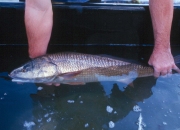| It may be January or July outdoors, but it's forever fall in the breeding room of the state's stock enhancement research facility at Port Manatee, where redfish (red drum) are fooled into spawning. While spawning season for this popular sport fish typically peaks in September when water temperatures cool and daylight shortens, it occurs here year-round, with a little help from biologists who manipulate light and water temperatures. |
 |
Adult brood stock plucked from the bay are transported to the hatchery, where DNA "fingerprints" are lifted from nickel-size finclips. Researchers isolate females with unique DNA strands for breeding so they can easily identify their offspring with finclips from future catches. |
 |
Occupants of the 5,000-gallon pelagic honeymoon suite are treated to everything but the mood music, which they create on their own. Amorous males turn a deep bronze and attract female tankmates by pushing their muscles against an inflated air bladder to produce a loud drumming sound. |
 |
Just after dark, with several males in pursuit, a female redfish releases a milky cloud of eggs - as many as a million in a single spawn - and the males spray a cloud of sperm into the water. Tiny oil globules keep the fertilized eggs afloat as they are whisked into an egg collector. Scientists measure the volume of the spawn before transferring the eggs to an incubator, where they will hatch within 20-30 hours. |
 |
Before they are three days old, the larval fish are carted to one of 12 one-acre ponds on site, draped with netting to fend off birds. About 40 percent of the hatchlings survive the first month, as compared to about 0.05 percent in the wild where birds and larger fish snatch up the tasty hatchlings. |
 |
In as little as one month, when the fish are hardy enough to release, they're transported by truck to vegetated stretches along the Alafia and Little Manatee rivers, where juvenile reds congregate and their populations can be monitored. Fish are grown to one of three sizes for release. Month-olds are about 1 to 1.5 inches long and the cheapest to raise at about 10 cents per fish. The hatchery also raises 3 to 4-inch fish and 6-inch juveniles at a cost of 25 cents to $1.25 per fish. While costs favor the smallest fish, the youngest are most likely to become fish food for larger creatures. Researchers are testing the ideal size-at-release. |
Photos courtesy of
Florida Marine Research Institute |
|



